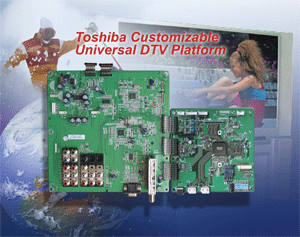The Ultimate Resource for Building Next-Generation Systems
SemiApps allows electronic design engineers to easily and quickly find product vendors who provide chipsets, application-focused ICs, customizable or programmable platforms and specialized components for particular applications. Each month we bring you our best on-line postings (www.semiapps.com/thismonth). Our choices, as presented here, are based on what other engineering readers like you looked at most during the previous few weeks.
Readers Choice: The best new application-specific ICs

Among the popular application-specific ICs this past month is one from Toshiba. The new LCD TV single-chip solution offers full 1,080-pixel high-definition TV support for the North American HDTV market. It’s one of many new HDTV related devices that were featured at the recent Consumer Electronics Show in Las Vegas.
The TC90413XBG IC incorporates MPEG-2 HD video and Dolby Digital audio decoding, a 64-bit 333-MHz MIPS processor, dual HDMI 1.3 ports and a back-end processor capable of driving both WXGA and 1080p display in one chip. The TC90413XBG is available as part of Toshiba’s new Customizable Universal DTV Platform (CUDP) for digital television applications.
Another new IC for digital TVs comes from Samsung Electronics . The company’s new digital TV receiver chip (S5H1432) is aimed at terrestrial digital video broadcasting (DVB-T), the digital broadcasting standard in Europe and Southeast Asia. Fabricated using Samsung’s 65-nm process technology on 300-mm wafers, the DVB-T receiver chip fully supports Europe’s NorDig unified standard for digital broadcasting. The power consumption level for this chip is 80 mW, less than one third of the conventional 250-mW average power consumption of existing solutions on the market, according to Samsung.
Analog Devices new 12-bit resolution 3-D comb video decoder offers an integrated 150-Msample/s digitizer for full-HD 1080p input formats. The ADV7802 single-chip solution improves video image and color quality in advanced high-definition televisions, video-processors, audio/video receiver (AVR) systems, and DVD recorders. The device is part of the company’s Advantiv advanced television chip family.
Engineering blogs of the month

The importance of power management in the new generation of portable electronic products is reflected in a popular recently posted blog from Bill Weiss of AnalogicTech. He reminds us that as portable system designers move to the more complex power management units, they will have to do a better job of anticipating market demands. Oftentimes, he says, a design team must add new functionality on short notice to meet a surprising new customer requirement or the rapid ramp up of a new technology. Integrated Wi-Fi, FM radio, digital audio broadcast, digital media broadcast, and digital video based products are among the applications mentioned by Bill Weiss.

Might you be interested in more performance from wireless video surveillance systems, color systems, wireless networking, and longer distance connectivity? That’s the subject of another popular blog this past month from Fujitsu Microelectronics America’s Haoming Huang. In his very interesting blog, Huang argues for the use of the fixed WIMAX standard for new video surveillance systems. “WiMAX provides significant performance advantages over WiFi, including higher throughput and longer distance connectivity. In fact, the maximum data throughput of 72 Mbps is a full 50 percent higher than can be achieved using the 802.11g WiFi specification,” he says. Sprinkled into his discussion are some good points on wireless camera designs.
Design Classics Library: Application notes of note and moreAmong the interesting application notes posted on the site comes one from Maxim Integrated Products. Maxim controls a variable-voltage power supply using its DS1809 pushbutton control device.
Many linear and switched-mode power supplies and voltage regulators use a resistor network as feedback into the regulator to adjust the voltage output. This is typically done either by varying the values of the individual resistors or using a mechanical potentiometer.
This application note discusses controlling a voltage regulator using a digital potentiometer with pushbutton controls. The DS1809 uses a “human interface” to the control of the voltage regulator. This can be used as a reference for other digitally controlled power supplies using other digital potentiometers that can be controlled by a microprocessor.
Marty Gold
Find out more on what visitors to SemiApps.com looked at most at www.SemiApps.com/thismonth.
Advertisement
Learn more about Electronic Products Magazine





